Monday, February 27. 2012
Everyone’s Trying to Track What You Do on the Web: Here’s How to Stop Them
Via Life Hacker
-----
It's no secret that there's big money to be made in violating your privacy. Companies will pay big bucks to learn more about you, and service providers on the web are eager to get their hands on as much information about you as possible.
So what do you do? How do you keep your information out of everyone else's hands? Here's a guide to surfing the web while keeping your privacy intact.
The adage goes, "If you're not paying for a service, you're the product, not the customer," and it's never been more true. Every day more news breaks about a new company that uploads your address book to their servers, skirts in-browser privacy protection, and tracks your every move on the web to learn as much about your browsing habits and activities as possible. In this post, we'll explain why you should care, and help you lock down your surfing so you can browse in peace.

Why You Should Care
Your personal information is valuable. More valuable than you might think. When we originally published our guide to stop Facebook from tracking you around the web, some people cried "So what if they track me? I'm not that important/I have nothing to hide/they just want to target ads to me and I'd rather have targeted ads over useless ones!" To help explain why this is short-sighted and a bit naive, let me share a personal story.
Before I joined the Lifehacker team, I worked at a company that traded in information. Our clients were huge companies and one of the services we offered was to collect information about people, their demographics, income, and habits, and then roll it up so they could get a complete picture about who you are and how to convince you to buy their products. In some cases, we designed web sites and campaigns to convince you to provide even more information in exchange for a coupon, discount, or the simple promise of other of those. It works very, very well.
The real money is in taking your data and shacking up with third parties to help them come up with new ways to convince you to spend money, sign up for services, and give up more information. Relevant ads are nice, but the real value in your data exists where you won't see it until you're too tempted by the offer to know where it came from, whether it's a coupon in your mailbox or a new daily deal site with incredible bargains tailored to your desires. It all sounds good until you realize the only thing you have to trade for such "exciting" bargains is everything personal about you: your age, income, family's ages and income, medical history, dietary habits, favorite web sites, your birthday...the list goes on. It would be fine if you decided to give up this information for a tangible benefit, but you may never see a benefit aside from an ad, and no one's including you in the decision. Here's how to take back that control.
Click for instructions for your browser of choice:
How to Stop Trackers from Following Where You're Browsing with Chrome
If you're a Chrome user, there are tons of great add-ons and tools designed to help you uncover which sites transmit data to third parties without your knowledge, which third parties are talking about you, and which third parties are tracking your activity across sites. This list isn't targeted to a specific social network or company—instead, these extensions can help you with multiple offenders.

- Adblock Plus - We've discussed AdBlock plus several times, but there's never been a better time to install it than now. For extra protection, one-click installs the Antisocial subscription for AdBlock. With it, you can banish social networks like Facebook, Twitter, and Google+ from transmitting data about you after you leave those sites, even if the page you visit has a social plugin on it.
- Ghostery - Ghostery does an excellent job at blocking the invisible tracking cookies and plug-ins on many web sites, showing it all to you, and then giving you the choice whether you want to block them one-by-one, or all together so you'll never worry about them again. The best part about Ghostery is that it's not just limited to social networks, but will also catch and show you ad-networks and web publishers as well.
- ScriptNo for Chrome - ScriptNo is much like Ghostery in that any scripts running on any site you visit will sound its alarms. The difference is that while Ghostery is a bit more exclusive about the types of information it alerts you to, ScriptNo will sound the alarm at just about everything, which will break a ton of websites. You'll visit the site, half of it won't load or work, and you'll have to selectively enable scripts until it's usable. Still, its intuitive interface will help you choose which scripts on a page you'd like to allow and which you'd like to block without sacrificing the actual content on the page you'd like to read.

- Do Not Track Plus - The "Do Not Track" feature that most browsers have is useful, but if you want to beef them up, the previously mentioned Do Not Track Plus extension puts a stop to third-party data exchanges, like when you visit a site like ours that has Facebook and Google+ buttons on it. By default, your browser will tell the network that you're on a site with those buttons—with the extension installed, no information is sent until you choose to click one. Think of it as opt-in social sharing, instead of all-in.
Ghostery, AdBlock Plus, and Do Not Track are the ones you'll need the most. ScriptNo is a bit more advanced, and may take some getting used to. In addition to installing extensions, make sure you practice basic browser maintenance that keeps your browser running smoothly and protects your privacy at the same time. Head into Chrome's Advanced Content Settings, and make sure you have third-party cookies blocked and all cookies set to clear after browsing sessions. Log out of social networks and web services when you're finished using them instead of just leaving them perpetually logged in, and use Chrome's "Incognito Mode" whenever you're concerned about privacy.

Mobile Browsing
Mobile browsing is a new frontier. There are dozens of mobile browsers, and even though most people use the one included on their device, there are few tools to protect your privacy by comparison to the desktop. Check to see if your preferred browser has a "privacy mode" that you can use while browsing, or when you're logged in to social networks and other web services. Try to keep your social network use inside the apps developed for it, and—as always—make sure to clear your private data regularly.
Some mobile browsers have private modes and the ability to automatically clear your private data built in, like Firefox for Android, Atomic Web Browser, and Dolphin Browser for both iOS and Android. Considering Dolphin is our pick for the best Android browser and Atomic is our favorite for iOS, they're worth downloading.
Extreme Measures
If none of these extensions make you feel any better, or you want to take protecting your privacy and personal data to the next level, it's time to break out the big guns. One tip that came up during our last discussion about Facebook was to use a completely separate web browser just for logged-in social networks and web services, and another browser for potentially sensitive browsing, like your internet shopping, banking, and other personal activities. If you have some time to put into it, check out our guide to browsing without leaving a trace, which was written for Firefox, but can easily be adapted to any browser you use.

If you're really tired of companies tracking you and trading in your personal information, you always have the option to just provide false information. The same way you might give a fake phone number or address to a supermarket card sign-up sheet, you can scrub or change personal details about yourself from your social network profiles, Google accounts, Windows Live account, and others.
Change your birthdate, or your first name. Set your phone number a digit off, or omit your apartment number when asked for your street address. We've talked about how to disappear before, and carefully examine the privacy and account settings for the web services you use. Keep in mind that some of this goes against the terms of service for those companies and services—they have a vested interest in knowing the real you, after all, so tread carefully and tread lightly if you want to go the "make yourself anonymous" route. Worst case, start closing accounts with offending services, and migrate to other, more privacy-friendly options.
These are just a few tips that won't significantly change your browsing experience, but can go a long way toward protecting your privacy. This issue isn't going anywhere, and as your personal information becomes more valuable and there are more ways to keep it away from prying eyes, you'll see more news of companies finding ways to eke out every bit of data from you and the sites you use. Some of these methods are more intrusive than others, and some of them may turn you off entirely, but the important thing is that they all give you control over how you experience the web. When you embrace your privacy, you become engaged with the services you use. With a little effort and the right tools, you can make the web more opt-in than it is opt-out.
Friday, February 24. 2012
USB stick can sequence DNA in seconds
Via NewScientist
-----
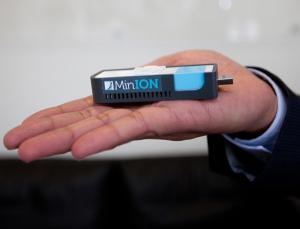
(Image: Oxford Nanopore Technologies)
It may look like an ordinary USB memory stick, but a little gadget that can sequence DNA while plugged into your laptop could have far-reaching effects on medicine and genetic research.
The UK firm Oxford Nanopore built the device, called MinION, and claims it can sequence simple genomes – like those of some viruses and bacteria – in a matter of seconds. More complex genomes would take longer, but MinION could also be useful for obtaining quick results in sequencing DNA from cells in a biopsy to look for cancer, for example, or to determine the genetic identity of bone fragments at an archaeological dig.
The company demonstrated today at the Advances in Genome Biology and Technology (AGBT) conference in Marco Island, Florida, that MinION has sequenced a simple virus called Phi X, which contains 5000 genetic base pairs.
Proof of principle
This is merely a proof of principle – "Phi X was the first DNA genome to be sequenced ever," says Nick Loman, a bioinformatician at the Pallen research group at the University of Birmingham, UK, and author of the blog Pathogens: Genes and Genomes. But it shows for the first time that this technology works, he says. "If you can sequence this genome you should be able to sequence larger genomes."
Oxford Nanopore is also building a larger device, GridION, for lab use. Both GridION and MinION operate using the same technology: DNA is added to a solution containing enzymes that bind to the end of each strand. When a current is applied across the solution these enzymes and DNA are drawn to hundreds of wells in a membrane at the bottom of the solution, each just 10 micrometres in diameter.
Within each well is a modified version of the protein alpha hemolysin (AHL), which has a hollow tube just 10 nanometres wide at its core. As the DNA is drawn to the pore the enzyme attaches itself to the AHL and begins to unzip the DNA, threading one strand of the double helix through the pore. The unique electrical characteristics of each base disrupt the current flowing through each pore, enough to determine which of the four bases is passing through it. Each disruption is read by the device, like a tickertape reader.
Long strands, and simple
This approach has two key advantages over other sequencing techniques: first, the DNA does not need to be amplified - a time-consuming process that replicates the DNA in a sample to make it abundant enough to make a reliable measurement.
Second, the devices can sequence DNA strands as long as 10,000 bases continuously, whereas most other techniques require the DNA to be sheared into smaller fragments of at most a few hundred bases. This means that once they have been read they have to be painstakingly reassembled by software like pieces of a jigsaw. "We just read the entire thing in one go," as with Phi X, says Clive Brown, Oxford Nanopore's chief technology officer.
But Oxford Nanopore will face stiff competition. Jonathan Rothberg, a scientist and entrepreneur who founded rival firm 454 Life Sciences, also announced at the AGBT conference that his start-up company, Ion Torrent, will be launching a desktop sequencing machine. Dubbed the Ion Proton, it identifies bases by using transistors to detect hydrogen ions as they are given off during the polymerisation of DNA.
This device will be capable of sequencing a human genome in 2 hours for around $1000, Rothberg claims. Nanopores are an "elegant" technology, he says, but Ion Torrent already has a foot in the door. "As we saw last summer with the E. coli outbreak in Germany, people are already now using it," he says.
Pocketful of DNA
By contrast, the MinION would take about 6 hours to complete a human genome, Brown claims, though the company plans to market the device for use in shorter sequencing tasks like identifying pathogens, or screening for genetic mutations that can increase risk of certain diseases. Each unit is expected to cost $900 when it goes on sale later this year.
"The biggest strength of nanopore sequencing is that it generates very long reads, which has been a limitation for most other technologies," says Loman. If the costs, quality, ease of use and throughput can be brought in line with other instruments, it will be a "killer technology" for sequencing, he says.
As for clinical applications, David Rasko at the Institute for Genome Sciences at the University of Maryland in Baltimore, says the MinION could have huge benefits. "It may have serious implications for public health and it could really change the way we do medicine," he says. "You can see every physician walking around the hospital with a pocketful of these things." And it will likely increase the number of scientists generating sequencing data by making the technology cheaper and more accessible, he says.
Thursday, February 23. 2012
Alan Turing's reading list (with readable links)
Via jgc.org
-----
Alex Bellos published a list of books
that Alan Turing took out from the school library as a child. I've
tracked down as many as possible should you wish to follow his reading.
1. Isotopes by Frederick William Aston (1922 edition).
2. Mathematical Recreations and Essays by W. W. Rouse Ball
3. Alice's Adventures in Wonderland, Game of Logic and Through The Looking Glass by Lewis Carroll.
4. The Common Sense of the Exact Sciences by William Kingdon Clifford.
5. Space, Time and Gravitation and The Nature of the Physical World by Sir Arthur Stanley Eddington.
6. Sidelights on Einstein by Albert Einstein.
7. The Escaping Club by A. J. Evans.
8. The New Physics by Arthur Haas.
9. Supply and Demand by Hubert D. Henderson.
10. Atoms and Rays and Phases of Modern Science by Sir Oliver Lodge.
11. Matter and Motion by James Clerk Maxwell.
12. The Theory of Heat by Thomas Preston.
13. Modern Chromatics, with applications to art and industry by Ogden Nicholas Rood.
14. Celestial Objects for Common Telescopes by Thomas William Webb.
15. The Recent Development of Physical Science by William Cecil Dampier Whetham.
16. Science and The Modern World by Alfred North Whitehead.
One book stands out as totally different from all the others: The Escaping Club by A. J. Evans.
MOTHER artificial intelligence forces nerds to do the chores… or else
Via Slash Gear
-----
If you’ve ever been inside a dormitory full of computer science undergraduates, you know what horrors come of young men free of responsibility. To help combat the lack of homemaking skills in nerds everywhere, a group of them banded together to create MOTHER, a combination of home automation, basic artificial intelligence and gentle nagging designed to keep a domicile running at peak efficiency. And also possibly kill an entire crew of space truckers if they should come in contact with a xenomorphic alien – but that code module hasn’t been installed yet.
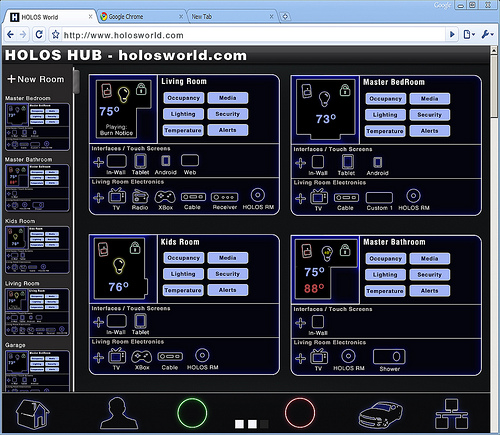
The project comes from the LVL1 Hackerspace, a group of like-minded
programmers and engineers. The aim is to create an AI suited for a home
environment that detect issues and gets its users (i.e. the people living in
the home) to fix it. Through an array of digital sensors, MOTHER knows
when the trash needs to be taken out, when the door is left unlocked, et
cetera. If something isn’t done soon enough, she it can even
disable the Internet connection for individual computers. MOTHER can
notify users of tasks that need to be completed through a standard
computer, phones or email, or stock ticker-like displays. In addition,
MOTHER can use video and audio tools to recognize individual users,
adjust the lighting, video or audio to their tastes, and generally keep
users informed and creeped out at the same time.
MOTHER’s abilities are technically limitless – since it’s all based on open source software, those with the skill, inclination and hardware components can add functions at any time. Some of the more humorous additions already in the project include an instant dubstep command. You can build your own MOTHER (boy, there’s a sentence I never thought I’d be writing) by reading through the official Wiki and assembling the right software, sensors, servers and the like. Or you could just invite your mom over and take your lumps. Your choice.
Wednesday, February 22. 2012
A Wirelessly Controlled Pharmacy Dispenses Drugs From Within Your Abdomen
Via PopSci
-----

In the future, implantable computerized dispensaries will replace trips to the pharmacy or doctor’s office, automatically leaching drugs into the blood from medical devices embedded in our bodies. These small wireless chips promise to reduce pain and inconvenience, and they’ll ensure that patients get exactly the amount of drugs they need, all at the push of a button.
In a new study involving women with osteoporosis, a wirelessly controlled implantable microchip successfully delivered a daily drug regimen, working just as well, if not better, than a daily injection. It could be an elegant solution for countless people on long-term prescription medicines, researchers say. Patients won’t have to remember to take their medicine, and doctors will be able to adjust doses with a simple phone call or computer command.
Pharmacies-on-a-chip could someday dispense a whole suite of drugs, at pre-programmed doses and at specific times, said Robert Langer, the Institute Professor at the David H. Koch Institute for Integrative Cancer Research at MIT, who is a co-author on the study.
“It really depends on how potent the drugs are,” he said. “There are a number of drugs for things like multiple sclerosis, cancer, and some vaccines that would be potent enough.”
Langer and fellow MIT professor Michael Cima developed an early version of an implantable drug-delivery chip in the late 1990s. They co-founded a company called MicroCHIPS Inc., which administered the study being published today in Science Translational Medicine. The team decided to work with osteoporosis patients because the disease, and the drug used to treat it, presented a series of special opportunities, Langer said. A widely used drug called teriparatide can reverse bone loss in people with severe osteoporosis, but it requires a daily injection to work properly. This means up to 75 percent of patients give up on the therapy, Langer said. It’s also a very potent drug that requires microgram doses, making it an ideal candidate for a long-term dispensary implant.
Getting the chips to work well required some tinkering on the part of the company, including the addition of a hermetic seal and drug-release system that can work in living tissue. The chip contains a cluster of tiny wells, about the size of a pinprick, which store the drug. Each well is sealed with an ultrathin layer of platinum and titanium, Langer said. At programmed times or at the patient’s command, an external radio-frequency device sends a signal to the chip, which applies a voltage to the metal film, melting it and releasing the drug. The wells melt one at a time.
“It’s like blowing a fuse, the way we’ve got it set,” Langer said. He said the amount of metal is near nanoscale levels and is not toxic.
The team also had to ensure the chips were secure and could not be hacked. The chips communicate via a special frequency called the Medical Implant Communications Service band, approved by both the FCC and the FDA. A bidirectional communications link between the chip and a receiver enables the upload of implant status information, including confirmation of dose delivery and battery life. A patient or doctor would then enter a special code to administer or change the dose, Langer said.
The research team recruited seven women in Denmark who had severe osteoporosis and surgically implanted the chips into their abdomens in January 2011. The chips stored 20 doses of the drug. The patients had the implants for a year, and they proved extremely popular, Langer said. “They didn’t think about the fact that they had it, since they didn’t have to have injections,” he said.
Ultimately, the device delivered dosages comparable to daily injections, and there were no negative side effects. There was no skipping the shot if a patient didn’t feel like visiting the doctor — complying with a prescription is of key importance, said Cima, the David H. Koch Professor of Engineering at MIT. “This avoids the compliance issue completely, and points to a future where you have fully automated drug regimens,” he said.
The study points out one interesting phenomenon that will inform future research and development on these types of implants. When you implant a device into a person’s body, the body forms a fibrous, collagen-based membrane that surrounds the foreign device. This can affect how well drugs can move from the device and into the body, which in turn affects dosage requirements and pharmaceutical potency. One of the aims of this study was to examine the effects of that collagen membrane, and the researchers found it did not have any deleterious effects on the drug.
Now that these chips have been proven to work, Langer and the others want to test them with other drugs and for longer dosage periods, he said. Because the well caps melt one at a time, the chips could be used to deliver different types of drugs, even those that would normally interact with each other if taken in shot or pill form, he said. The team wants to build a version with 365 doses to see how well it works.
It could even be used as a long-term sensing device, he said, an interesting possibility of its own. Medical sensing implants can degrade once they’re in the body, so implants that could check for things like blood sugar or cancer antibodies can lose their effectiveness. But a chip with multiple sensors can work a lot longer — once a sensor is befouled, simply melt another well and expose a fresh one, Langer said.
The ultimate goal is to create a chip that could combine sensing and drug delivery — an implantable diagnostic machine that can deliver its own therapy.
“Someday it would be great to combine everything, but that will obviously take longer,” Langer said.
Monday, February 20. 2012
Envelope for an artificial cell
Via PhysOrg
-----
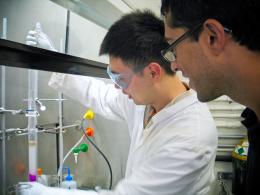
Neal Davaraj watches as undergraduate student Weilong Li works on a next
step in their quest to create an entirely artificial cell.
Chemists have taken an important step in making artificial life forms from scratch. Using a novel chemical reaction, they have created self-assembling cell membranes, the structural envelopes that contain and support the reactions required for life.
Neal Devaraj, assistant professor of chemistry at the University of California, San Diego, and Itay Budin, a graduate student at Harvard University, report their success in the Journal of the American Chemical Society.
“One of our long term, very ambitious goals is to try to make an artificial cell, a synthetic living unit from the bottom up – to make a living organism from non-living molecules that have never been through or touched a living organism,” Devaraj said. “Presumably this occurred at some point in the past. Otherwise life wouldn’t exist.”
By assembling an essential component of earthly life with no biological precursors, they hope to illuminate life’s origins.
“We don’t understand this really fundamental step in our existence, which is how non-living matter went to living matter,” Devaraj said. “So this is a really ripe area to try to understand what knowledge we lack about how that transition might have occurred. That could teach us a lot – even the basic chemical, biological principles that are necessary for life.”
Molecules that make up cell membranes have heads that mix easily with water and tails that repel it. In water, they form a double layer with heads out and tails in, a barrier that sequesters the contents of the cell.
Devaraj and Budin created similar molecules with a novel reaction that joins two chains of lipids. Nature uses complex enzymes that are themselves embedded in membranes to accomplish this, making it hard to understand how the very first membranes came to be.
“In our system, we use a sort of primitive catalyst, a very simple metal ion,” Devaraj said. “The reaction itself is completely artificial. There’s no biological equivalent of this chemical reaction. This is how you could have a de novo formation of membranes.”
They created the synthetic membranes from a watery emulsion of an oil and a detergent. Alone it’s stable. Add copper ions and sturdy vesicles and tubules begin to bud off the oil droplets. After 24 hours, the oil droplets are gone, “consumed” by the self-assembling membranes.
Although other scientists recently announced the creation of a “synthetic cell,” only its genome was artificial. The rest was a hijacked bacterial cell. Fully artificial life will require the union of both an information-carrying genome and a three-dimensional structure to house it.
The real value of this discovery might reside in its simplicity. From commercially available precursors, the scientists needed just one preparatory step to create each starting lipid chain.
“It’s trivial and can be done in a day,” Devaraj said. “New people who join the lab can make membranes from day one.”
Provided by University of California - San Diego (news : web)
Friday, February 17. 2012
The Pirate Bay declares 3D printed “physibles” as the next frontier of piracy
Via Extreme Tech
-----
While the subject of online piracy is certainly nothing new, the recent protests against SOPA and the federal raid on Megaupload have thrust the issue into mainstream media. More than ever, people are discussing the controversial topic while content creators scramble to find a way to try to either shut down or punish sites and individuals that take part in the practice. Despite these efforts, online piracy continues to be a thorn in Big Media’s side. With the digital media arena all but conquered by piracy, the infamous site The Pirate Bay (TPB) has begun looking to the next frontier to be explored and exploited. According to a post on its blog, TPB has declared that physical objects named “physibles” are the next area to be traded and shared across global digital smuggling routes.
TPB defines a physible as “data objects that are able (and feasible) to become physical.” Namely, items that can be created using 3D scanning and printing technologies, both of which have become much cheaper for you to actually own in your home. At CES this year, MakerBot Industries introduced its latest model which is capable of printing objects in two colors and costs under $2,000. With the price of such devices continuing to drop, 3D printing is going to be part of everyday life in the near future. Where piracy is going to come in is the exchange of the files (3D models) necessary to create these objects.
A 3D printer is essentially a “CAD-CAM” process. You use a computer-aided design (CAD) program to design a physical object that you want made, and then feed it into a computer-aided machining (CAM) device for creation. The biggest difference is that traditional CAM setups, the process is about milling an existing piece of metal, drilling holes and using water jets to carve the piece into the desired configuration. In 3D printing you use extrusion to actually create what is illustrated in the CAD file. Those CAD files are the physibles that TPB is talking about, since they are digital they are going to be as easily transferred as an MP3 or movie is right now.

It isn’t too far outside the realm of possibility that once 3D printing becomes a part of everyday life, companies will begin to sell the CAD files and the rights to be able to print proprietary items. If the technology continues to advance at the same rate, in 10 or 20 years you might be printing a new pair of Nikes for your child’s basketball game right in your home (kind of like the 3D printed sneakers pictured above). Instead of going to the mall and paying $120 for a physical pair of shoes in a retail outlet, you will pay Nike directly on the internet and receive the file necessary to direct your printer to create the sneakers. Of course, companies will do their level best to create DRM on these objects so that you can’t freely just print pair after pair of shoes, but like all digital media it will be broken be enterprising individuals.
TPB has already created a physibles category on its site, allowing you to download plans to be able to print out such things as the famous Pirate Bay Ship and a 1970 Chevy hot rod. For now it’s going to be filled with user-created content, but in the future you can count on it being stocked with plans for DRM-protected objects.
Thursday, February 16. 2012
Google Sky Map development ends, app goes open source
-----
If you’re a fan of Google’s augmented reality astronomy app Google Sky Map, I’ve got good news and bad news for you. Google announced that major development on the app has ended, so there will be no more major official releases from the company. On the plus side, they’ve decided to release the open-source code for Sky Map, so given enough developer interest it should be around for quite some time.
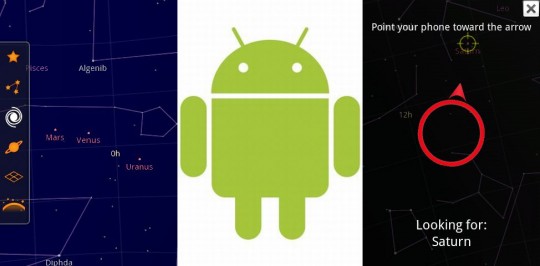
Sky Map started as one of Google’s famous 20% projects, which six of its employees launched by working in their company-sponsored spare time. The application was one of Android’s first showpiece apps, combining basic astronomical data overlaid on a smartphone camera to easily identify constellations, planets and other heavenly bodies by simply pointing the phone towards the sky. The free app has been downloaded over 10 million times from the Android Market.
Google is working with Carnegie Melon University so that its students can continue direct development. The company didn’t say if direct updated with computer scientist students’ code would make it into the android Market, but it’s a pretty safe bet. If you’ d like to give it a try for yourself, you can download the open-source code here. I fully expect a Star Trek themed version of Sky Map in the next few weeks which will allow me to view the Alpha Quadrant from my smartphone – get to it, devs.
Tuesday, February 14. 2012
Brendan Dawes: Man + MakerBot = Useful Household Items
Via Core77
-----
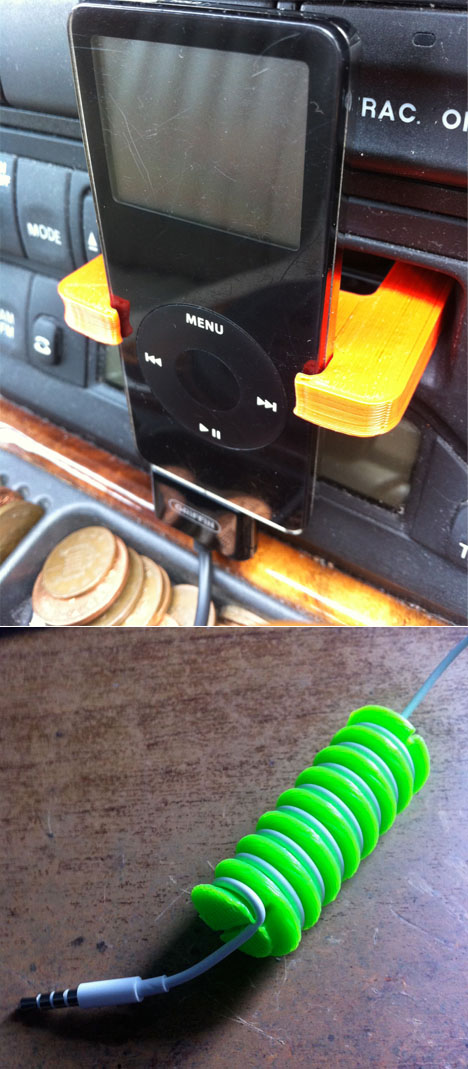
One of the key reasons I haven't ponied up for a MakerBot yet is because I'm still not sure it will be able to produce the types of things I specifically would like to make. It would be neat if they had some sort of "try before you buy" scheme where you could e-mail them plans and get the part back in the mail for a fee, to see if it met your expectations.
Until something like that develops, one blog I've found that makes for interesting reading is Brendan Dawes' Everything I Make with my MakerBot, whereby he documents his projects dating back to December of 2010, when he first bought the machine.
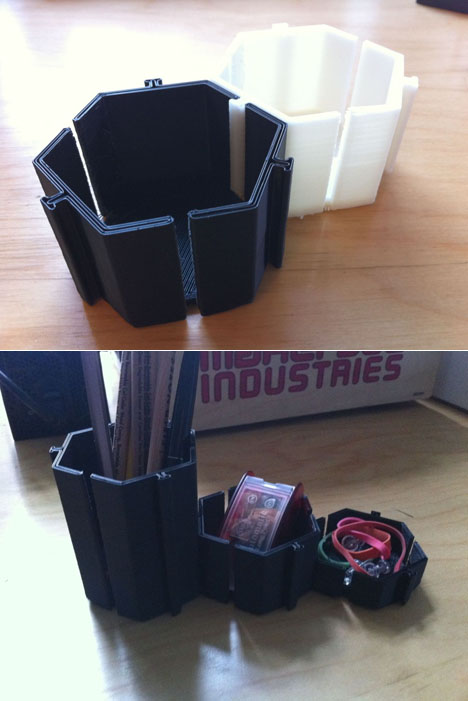
Although technically an artist and DJ, Dawes has enough ID in his bones to hint at what things you, as an industrial designer, would probably come up with if you had a MakerBot lying around the house. Thus we see things like cable wraps, a bicycle mount for a camera, a notebook writing utensil holder perfectly modified to store his preferred type of pencil, a modular desktop organizer system, and more.
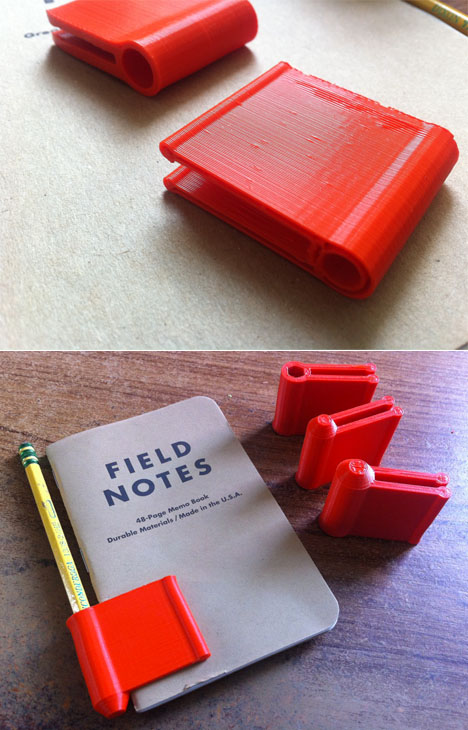
Also informative is that he shows us his failures as well as his successes, revealing miscalculated parts and botched jobs resulting from a particular bolt on the machine not being tight enough. As I know I'd produce my fair share of errors, it's illuminating to see what can go wrong and how you can take steps to avoid it.
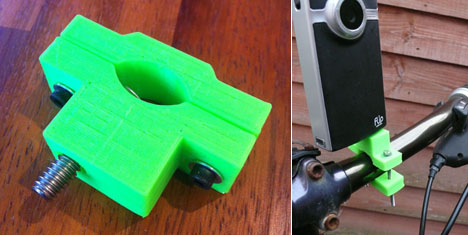
As IDers we're constantly looking at things and thinking "Jeez, if I only had something shaped like [this] then I could use it for [that.]" Dawes' blog really drives home that he continually has thoughts like these, and is able to quickly turn those into a reality.
Monday, February 13. 2012
Computer Algorithm Used To Make Movie For Sundance Film Festival
Via Singularity Hub
-----
Indie movie makers can be a strange bunch, pushing the envelope of their craft and often losing us along the way. In any case, if you’re going to produce something unintelligible anyway, why not let a computer do it? Eve Sussmam and the Rufus Corporation did just that. She and lead actor Jeff Wood traveled to the Kazakhstan border of the Caspian Sea for two years of filming. But instead of a movie with a beginning, middle and end, they shot 3,000 individual and unrelated clips. To the clips they added 80 voice-overs and 150 pieces of music, mixed it all together and put it in a computer. A program on her Mac G5 tower, known at Rufus as the “serendipity machine,” then splices the bits together to create a final product.
As you might imagine, the resultant film doesn’t always make sense. But that’s part of the fun! As the Rufus Corporation writes on their website, “The unexpected juxtapositions create a sense of suspense alluding to a story that the viewer composes.”
It’s a clever experiment even if some viewers end up wanting to gouge their eyes out after a sitting. And there is some method to their madness. The film, titled “whiteonwhite:algorithnoir,” is centered on a geophysicist named Holz (played by Wood) who’s stuck in a gloomy, 1970’s-looking city operated by the New Method Oil Well Cementing Company. Distinct scenes such as wire tapped conversations or a job interview for Mr. Holz are (hopefully) woven together by distinct voiceovers and dialogues. When the scenes and audio are entered into the computer they’re tagged with keywords. The program then pieces them together in a way similar to Pandora’s stringing together of like music. If a clip is tagged “white,” the computer will randomly select from tens of other clips also having the “white” tag. The final product is intended to be a kind of “dystopian futuropolis.” What that means, however, changes with each viewing as no two runs are the same.
Watching the following trailer, I actually got a sense…um, I think…of a story.
Rufus Corporation says the movie was “inspired by Suprematist quests for transcendence, pure space and artistic higher ground.” I have no idea what that means but I hope they’ve achieved it. Beautiful things can happen when computers create art. And it’s only a matter of time before people attempt the same sort of thing with novel writing. Just watching the trailer, it’s hard to tell if the movie’s any good or not. I missed the showings at the Sundance Film Festival, but even so, they probably didn’t resemble the trailer anyway. And that’s okay, because that’s the whole point.
[image credits: Rufus Corporation and PRI via YouTube][video credit: PRI via YouTube]
Quicksearch
Popular Entries
- The great Ars Android interface shootout (130671)
- Norton cyber crime study offers striking revenue loss statistics (100879)
- MeCam $49 flying camera concept follows you around, streams video to your phone (99675)
- Norton cyber crime study offers striking revenue loss statistics (57108)
- The PC inside your phone: A guide to the system-on-a-chip (56964)



